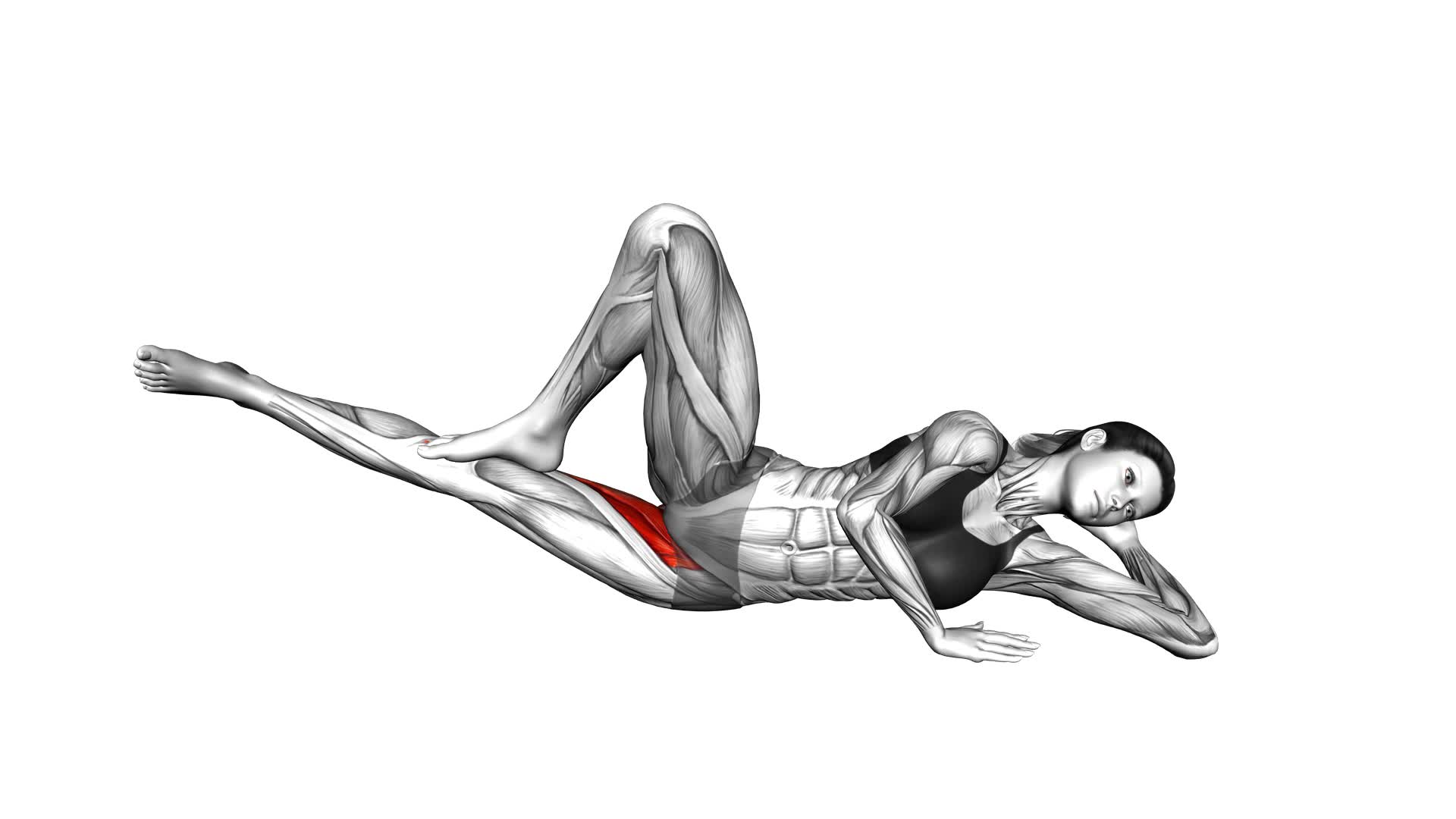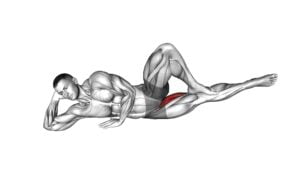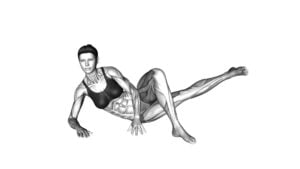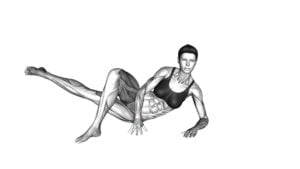Bodyweight Side Lying Leg Adduction (female) – Video Exercise Guide & Tips

Get ready to work those inner thighs with bodyweight side lying leg adduction!
Watch This Exercise Video
This exercise is perfect for females looking to strengthen and tone their lower body.
In this video exercise guide, you'll learn the proper form and technique, as well as modifications and progressions for all fitness levels.
Avoid common mistakes and discover tips for incorporating this exercise into your fitness routine.
Watch the video and get ready to feel the burn!
Key Takeaways
- Bodyweight Side Lying Leg Adduction strengthens inner thigh muscles.
- It improves hip stability and targets adductor muscles responsible for leg adduction.
- This exercise increases overall lower body strength and enhances balance and stability in the hips and pelvis.
- Proper form and technique, along with gradual progression, are important for effective execution.
Benefits of Bodyweight Side Lying Leg Adduction
To experience the benefits of bodyweight side lying leg adduction, you can strengthen your inner thigh muscles and improve hip stability. This exercise specifically targets the adductor muscles, which are responsible for bringing your legs together. By performing this exercise regularly, you can increase the strength and tone of these muscles, leading to improved overall lower body strength and stability.
One of the key benefits of bodyweight side lying leg adduction is the activation of your inner thigh muscles. These muscles, known as the adductors, are often underutilized in daily activities and traditional exercises. By targeting them with this exercise, you can develop stronger inner thighs, which can contribute to better balance and stability in your hips and pelvis.
Another benefit of this exercise is improved hip stability. The adductors play a crucial role in stabilizing the hip joint during movement. When these muscles are weak or imbalanced, it can lead to hip instability and increased risk of injury. By incorporating bodyweight side lying leg adduction into your routine, you can strengthen these muscles and enhance the stability of your hips.
To ensure that you're reaping the full benefits of this exercise, it's important to maintain proper form. Start by lying on your side with your legs extended straight. Engage your core and lift your top leg, keeping it straight as you slowly lower it back down. Avoid any swinging or jerking movements, and focus on using the inner thigh muscles to control the motion. Aim for a controlled and smooth movement throughout the exercise.
Proper Form and Technique for Females
Improving your form and technique for bodyweight side lying leg adduction is crucial for maximizing the benefits of this exercise, especially for females. By following the proper form and technique, you can ensure that you're targeting the right muscles and minimizing the risk of injury.
Here are some tips to help you perform this exercise correctly:
- Align your body: Lie on your side with your legs stacked on top of each other. Keep your hips and shoulders in line with each other to maintain proper alignment throughout the movement.
- Engage your core: Before starting the exercise, engage your core muscles by pulling your belly button towards your spine. This will help stabilize your body and protect your lower back.
- Control the movement: Slowly lift your top leg towards the ceiling, focusing on using your inner thigh muscles to perform the adduction. Avoid using momentum or swinging your leg.
- Maintain proper breathing: Inhale as you lower your leg back down to the starting position, and exhale as you lift it up. This will help you maintain control and stability throughout the exercise.
Equipment Needed for the Exercise
To perform the bodyweight side lying leg adduction exercise, you'll need some exercise equipment. The required equipment includes a mat or a comfortable surface to lie on. If you don't have access to a mat, you can use a towel or a soft carpeted area as an alternative.
Required Exercise Equipment
You will need an exercise mat for the Bodyweight Side Lying Leg Adduction (female) exercise.
Here are some minimal equipment options and tips for incorporating them into your workout:
- Exercise mat: Provides cushioning and support for your body during the exercise.
- Resistance band: Adds extra resistance to the movement, challenging your muscles even more.
- Ankle weights: Increases the intensity of the exercise by adding weight to your legs.
- Stability ball: Places your body in an unstable position, engaging more muscles for balance and stability.
To incorporate these equipment options, simply place the resistance band around your thighs or ankles, attach ankle weights to your legs, or rest your legs on the stability ball while performing the side lying leg adduction.
Remember to choose the equipment that suits your fitness level and goals.
Minimal Equipment Options
You will need minimal equipment for the Bodyweight Side Lying Leg Adduction (female) exercise. This exercise requires a mat or a comfortable surface to lie on. No additional equipment is necessary to perform the leg adduction movement.
However, if you want to add resistance and increase the challenge, you can use ankle weights or resistance bands. Ankle weights can be strapped around your ankles to provide extra resistance as you perform the exercise. Resistance bands can be placed around your thighs to add tension and make the movement more challenging.
These equipment options allow for modifications and progressions in the exercise, helping you to continuously challenge your muscles and improve your strength and stability. Remember to choose the appropriate level of resistance that suits your fitness level and goals.
Modifications and Progressions for All Fitness Levels
For all fitness levels, there are various modifications and progressions available for the Bodyweight Side Lying Leg Adduction exercise. Whether you're a beginner or an advanced athlete, you can tailor this exercise to suit your needs and challenge yourself as you progress. Here are some modifications and progressions to consider:
- Resistance Band: To add more resistance and intensity to the exercise, you can use a resistance band. Simply wrap it around your thighs and perform the side lying leg adduction as usual. The band will provide added resistance, making the exercise more challenging.
- Weighted Ankle Cuff: If you find the bodyweight version too easy, you can use a weighted ankle cuff to increase the difficulty. Attach the cuff to your ankle and perform the exercise as usual. The added weight will engage your muscles more, making the exercise more effective.
- Elevated Legs: To further challenge your muscles, you can elevate your legs during the exercise. Use a bench or a step to raise your legs off the ground while performing the side lying leg adduction. This modification will increase the range of motion and activate your muscles even more.
- Single Leg Variation: Once you have mastered the basic side lying leg adduction, you can progress to a single leg variation. Lift one leg off the ground and perform the exercise with the other leg. This progression will require more stability and strength, targeting your muscles in a different way.
Common Mistakes to Avoid
To ensure proper form during the bodyweight side lying leg adduction exercise, make sure to check your form regularly.
Keep your core engaged and focus on using the muscles in your inner thighs to perform the movement.
Avoid excessive hip movement by keeping your hips stable throughout the exercise.
Form Check Tips
Performing the bodyweight side lying leg adduction exercise correctly is crucial for optimal results. To help you avoid common mistakes and ensure proper form, here are some form check tips:
- Keep your body aligned: Make sure your body is in a straight line from head to toe throughout the exercise.
- Engage your core: Activate your core muscles by drawing your belly button in towards your spine.
- Control the movement: Slowly lower your top leg towards the floor, maintaining control and avoiding any swinging or jerking motions.
- Modify and progress: If you find the exercise too challenging, you can modify it by using a resistance band or reducing the range of motion. On the other hand, if you want to increase the difficulty, you can add ankle weights or perform the exercise on an inclined surface.
Proper Muscle Engagement
Engage the correct muscles by focusing on proper form and avoiding common mistakes.
To ensure proper muscle activation during the bodyweight side lying leg adduction exercise, it's crucial to maintain a straight alignment of the body from head to toe. Avoid collapsing or slouching the upper body, as this can shift the focus away from the targeted muscles. Additionally, be mindful of keeping the hips stacked and stable throughout the movement, as any excessive movement can reduce the activation of the adductor muscles.
To further enhance muscle engagement, you can incorporate exercise variations such as using resistance bands or ankle weights. These variations can provide additional resistance and challenge the muscles even more, resulting in greater activation and overall effectiveness of the exercise.
Avoiding Excessive Hip Movement
To avoid excessive hip movement during the bodyweight side lying leg adduction exercise, focus on maintaining stability and control throughout the movement. Here are some tips to help you improve your hip stability:
- Keep your core engaged: Activate your abdominal muscles to provide a stable base for your hips.
- Control the range of motion: Avoid swinging your leg too far or letting it drop too low. Aim for controlled and deliberate movements.
- Use your glutes: Focus on squeezing your glute muscles to initiate the movement, rather than relying solely on your hip flexors.
- Keep your hips stacked: Make sure your top hip stays directly above your bottom hip throughout the exercise. This will help prevent any excessive movement or rotation.
Tips for Incorporating the Exercise Into Your Fitness Routine
You can easily incorporate the bodyweight side lying leg adduction exercise into your fitness routine. Here are some tips to help you get started:
For beginners, it's important to start with proper form and alignment. Lie on your side with your legs straight and stacked on top of each other. Place your bottom arm under your head for support. Keep your core engaged throughout the exercise.
To perform the side lying leg adduction, lift your top leg up towards the ceiling while keeping your bottom leg grounded. Slowly lower your leg back down to the starting position. Repeat for the desired number of repetitions.
If you find this exercise too challenging, you can modify it by bending your bottom leg at the knee. This will provide more stability and make it easier to perform the movement.
To add variation to the exercise, you can use ankle weights or a resistance band around your thighs to increase the intensity. This will help to further strengthen and tone your inner thighs.
Incorporating the bodyweight side lying leg adduction into your fitness routine is a great way to target and tone your inner thighs. Start with a few repetitions and gradually increase as you get stronger. Remember to listen to your body and take breaks as needed.
Frequently Asked Questions
How Many Sets and Reps Should I Do for Bodyweight Side Lying Leg Adduction?
To maximize the benefits of bodyweight side lying leg adduction, it's important to determine the right sets and reps for your fitness level. Start with 2-3 sets of 10-15 reps per leg and gradually increase as you become more comfortable.
This exercise targets your inner thighs, helping to strengthen and tone them. Remember to maintain proper form and engage your core throughout the movement for optimal results.
Can Men Also Perform Bodyweight Side Lying Leg Adduction Exercise?
Yes, men can also participate in the bodyweight side lying leg adduction exercise. This exercise targets the inner thigh muscles and can be beneficial for both men and women.
To perform the exercise, lie on your side with your legs extended and lift the top leg up towards the ceiling.
You can also modify the exercise by using resistance bands or ankle weights for added intensity.
Remember to start with a weight that's challenging but manageable for your fitness level.
Is It Normal to Feel a Burning Sensation in the Inner Thigh During the Exercise?
Feeling a burning sensation in your inner thigh during exercise is normal. It's a sign that your muscles are working hard.
The bodyweight side lying leg adduction exercise targets the inner thigh muscles, so it's common to feel some discomfort or burning sensation in that area.
However, if the pain becomes severe or persists after the exercise, it's important to consult a healthcare professional to rule out any potential injuries or underlying conditions.
Are There Any Alternatives to the Bodyweight Side Lying Leg Adduction Exercise?
Looking for alternative exercises to the bodyweight side lying leg adduction?
There are several options you can try. One alternative is the standing cable hip abduction exercise, which targets the same muscle group.
Another option is the seated hip adduction exercise using a machine. Both exercises offer similar benefits to the bodyweight version, such as targeting the inner thigh muscles and improving hip stability.
Can Bodyweight Side Lying Leg Adduction Help With Reducing Cellulite on the Thighs?
Yes, bodyweight exercises like side lying leg adduction can be effective for reducing cellulite on the thighs. By targeting the muscles in the inner thighs, this exercise helps to tone and strengthen the area, which can improve the appearance of cellulite.
Additionally, bodyweight exercises are a convenient and cost-effective way to work out, making them a great option for cellulite reduction. Incorporating this exercise into your fitness routine along with a healthy diet can yield positive results.
Conclusion
In conclusion, bodyweight side lying leg adduction is a beneficial exercise for females that targets the inner thigh muscles. By following proper form and technique, using the necessary equipment, and making modifications as needed, individuals of all fitness levels can perform this exercise safely and effectively.
Avoiding common mistakes and incorporating this exercise into your fitness routine can help improve overall lower body strength and stability.

Author
Years ago, the spark of my life’s passion ignited in my mind the moment I stepped into the local gym for the first time. The inaugural bead of perspiration, the initial endeavor, the very first surge of endorphins, and a sense of pride that washed over me post-workout marked the beginning of my deep-seated interest in strength sports, fitness, and sports nutrition. This very curiosity blossomed rapidly into a profound fascination, propelling me to earn a Master’s degree in Physical Education from the Academy of Physical Education in Krakow, followed by a Sports Manager diploma from the Jagiellonian University. My journey of growth led me to gain more specialized qualifications, such as being a certified personal trainer with a focus on sports dietetics, a lifeguard, and an instructor for wellness and corrective gymnastics. Theoretical knowledge paired seamlessly with practical experience, reinforcing my belief that the transformation of individuals under my guidance was also a reflection of my personal growth. This belief holds true even today. Each day, I strive to push the boundaries and explore new realms. These realms gently elevate me to greater heights. The unique combination of passion for my field and the continuous quest for growth fuels my drive to break new ground.







